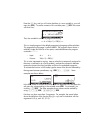
Page 4-1
Chapter 4
Calculations with complex numbers
This chapter shows examples of calculations and application of functions to
complex numbers.
Definitions
A complex number z is a number written as z = x + iy, where x and y are real
numbers, and i is the imaginary unit defined by i
2
= -1. The complex number
x+iy has a real part, x = Re(z), and an imaginary part, y = Im(z). We can
think of a complex number as a point P(x,y) in the x-y plane, with the x-axis
referred to as the real axis, and the y-axis referred to as the imaginary axis.
Thus, a complex number represented in the form x+iy is said to be in its
Cartesian representation. An alternative Cartesian representation is the ordered
pair z = (x,y). A complex number can also be represented in polar coordinates
(polar representation) as z = re
i
θ
= r
⋅
cos
θ
+ i r
⋅
sin
θ
, where r = |z|
=is the magnitude of the complex number z, and
θ
= Arg(z) =
arctan(y/x) is the argument of the complex number z. The relationship between
the Cartesian and polar representation of complex numbers is given by the
Euler formula: e
i
θ
= cos
θ
+ i sin
θ.
The complex conjugate of a complex
number z = x + iy = re
i
θ
, is
⎯
z = x – iy = re
-i
θ
. The complex conjugate of i can
be thought of as the reflection of z about the real (x) axis. Similarly, the
negative of z, –z = -x-iy = - re
i
θ
, can be thought of as the reflection of z about
the origin.
Setting the calculator to COMPLEX mode
When working with complex numbers it is a good idea to set the calculator to
complex mode, using the following keystrokes:
H)@@CAS@ ˜˜™@@CHK@
The COMPLEX mode will be selected if the CAS MODES screen shows the
option _Complex checked, i.e.,
22
yx +


















